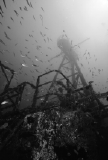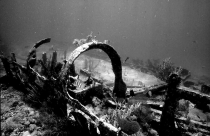

![]()
Have a Question or Comment?
What can we do to make this site more useful to you?
Note: Adobe Acrobat Reader required for PDF documents.
Problems accessing PDF documents?
Download the document to disk:
Mac Users: Option-click
PC users: Right-click
Last Updated 12/13/2000
 |

![]()
A trail of historic shipwrecks is scattered along the treacherous coral reefs and buried in the sandy shallows a few miles off the Florida Keys, and these wrecks have many tales to tell. They can tell us about individuals who came before us, why they were here, and their difficulty in navigating these waters. There are many reasons these ships lie broken on the bottom including an inability to accurately determine position, inaccurate charts, lack of navigational aids (lighthouses and buoys), unpredictable currents, lack of wind, storms, and human error. The nine sites on the Shipwreck Trail represent three broad periods of Keys maritime history: European Colonial, American and Modern. During the European Colonial period explorers called the islands off South Florida’s coast Los Martires because their gnarled skyline reminded the mariners of tortured Christian martyrs. The shallow reefs of this region and the sudden changes of weather posed a threat to their safe passage through the Straits of Florida on the return voyage to Europe. Ships laden with the natural wealth of South and Central America all too often became wrecked on the dangerous reefs of the Florida Keys and Bahama Islands. In July of 1733, twenty-two Spanish ships departed from Havana heading through the Straits for home. A sudden violent hurricane slammed into the flotilla, scattering the ships and sending many to their doom. The reef near Indian Key claimed the Dutch-built ship, San Pedro. Today, an anchor, replica cannons, and a ballast pile are the only remaining evidence of the tragedy of the San Pedro — the oldest wreck on the Shipwreck Trail.
European shipping declined by the beginning of the 19th century in the Straits of Florida while American shipping expanded dramatically. The newly Americanized port of New Orleans shipped the commerce of the rapidly growing American interior throughout the New World. This increase in shipping was accompanied by an increase in shipwrecks in the Keys. During the middle 1800s, so many ships went down in the Keys that several thriving communities of wreckers sprang up to retrieve cargo and vessel remains for resale. There are two shipwrecks of this period included on the trail: the Adelaide Baker, south of Duck Key, and a wreck believed to be the North America located on Delta Shoals. These wrecks illustrate the way in which pieces of these sunken archeological treasures tell tales of the vessels themselves—the materials, the craftsmanship, and the artisans’ methods of construction. When viewing these remains we can reflect on what the lives of the sailors and passengers aboard may have been like.
Shipwrecks still occur in modern times despite dramatic improvements in propulsion and navigation. The City of Washington and Benwood are examples of modern vessels that came to grief in the Keys. Other ships were sunk deliberately as artificial reefs. The Amesbury, Duane, Eagle and Thunderbolt serve the same functions in this underwater trail as do museums on land. These ships were built over the last 125 years by different countries for a variety of purposes; the Eagle for cargo transport, the Amesbury for military combat, and the Duane and Thunderbolt for coastal defense.
![]()
 |
One of the goals of the National Marine Sanctuary System is to provide opportunities for people to learn about our maritime heritage. Through the Shipwreck Trail, the Florida Keys National Marine Sanctuary is seeking to make our rich maritime heritage more visible and to encourage an appreciation and understanding of these irreplaceable remnants of our past. The diversity of sites and locations covered by this project provide something of interest for everyone. While teaching about our nation’s history and maritime culture, the Shipwreck Trail will also help divert diving pressure from the major natural reefs. Not only do historians, biologists, and fishers seek out these shipwrecks, so do fish! Shipwrecks become artificial reefs, providing a special setting for the brightly colored tropical fish to perform their nature-choreographed water ballets.
![]()
For each of the nine Shipwreck Trail sites there is an underwater site guide available which provides the shipwreck and mooring buoy positions, history, a site map, and identifies marine life you can expect to see. Conditions on the Shipwreck Trail sites vary from easy dives in shallow water to deeper dives of l00 feet or more where swift currents may be encountered. Some of the deeper sites require mooring to submerged buoys. Diving and snorkeling charters, underwater site guides, and additional information on the conditions for each site are available from local dive shops.
![]()
Each of these sites was chosen because of its historic, biologic, and aesthetic value. Please help protect them so that they may be enjoyed by future generations. Remember to control your buoyancy. Shipwreck structures can be as fragile as the marine life they support. Repeated human or anchor contact will hasten site deterioration. These resources are the shared cultural and historical legacy, as well as the property, of the people of the United States. Removing artifacts or damaging these cultural resources in any way is forbidden by law and violates the public trust by depriving others of the opportunity to view and enjoy these submerged resources.
For more information contact the Florida Keys National Marine Sanctuary:
| Upper Keys | Marathon | Lower Keys |
| PO Box 1083 Key Largo, FL 33037 (305)852-7717 fax: (305)853-0877 | PO Box 500368 Marathon, FL 33050 (305)743-2437 fax: (305) 743-2357 | P.O. Box 1938 Key West, FL 33041 (305)292-0311 fax: (305)292-5065 |
| Chambers of Commerce:
Key Largo: (305)451-1414 |
||

